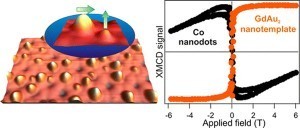CO NANODOT ARRAYS GROWN ON A GDAU2 TEMPLATE: SUBSTRATE/NANODOT ANTIFERROMAGNETIC COUPLING

One of the biggest challenges in magnetic storage and spintronics is to fabricate arrays of magnetic nanodots. The objective is, on one side, to achieve the densest network made of independent magnetic nanoelements and, on the other, to develop functional interfaces for spintronics, with tailored anisotropies and spin textures. Self-organization on nanoscale templates appears as a feasible route for cheap and fast fabrication processes. This is realized in a straightforward way by vapor epitaxy of ferromagnetic atoms, such as Co and Fe, or molecules on nanostructured templates, namely crystal surfaces that exhibit spontaneous reconstructions, dislocation patterns, periodic faceting, or step arrays. Most of these studies have been realized on noble and refractory metal substrates, such as Au, Pt, W, Mo or Ag, which are chemically and magnetically inert against ferromagnetic adsorbates. However, more exotic and technologically appealing configurations can be obtained using magnetic templates. These usually are more reactive and difficult to prepare, and hence have been scarcely investigated.
Here, we address the characterization of a periodic Co nanodot array self-assembled on a ferromagnetic nanotemplate of GdAu2, which is spontaneously formed by Gd deposition on a Au(111) crystal. Focus of this article is the fundamental question regarding the nature of the anisotropy and magnetic coupling across the interface between the nanostructures and the template. GdAu2 monolayers and bilayers grown on a Au(111) surface are characterized by a regular moiré superstructure, triggered by the lattice mismatch of the compound with the underlying Au substrate. This GdAu2 moiré works as an excellent template for self-organization of Co nanodots at room temperature (RT). To determine magnetic substrate/nanodot coupling in the Co/GdAu2/Au(111) system here we combine the element sensitive technique X-ray Magnetic Circular Dichroism (XMCD), with full-potential linearized augmented plane wave (FLAPW) calculations, particularly adequate to study magnetic properties.



